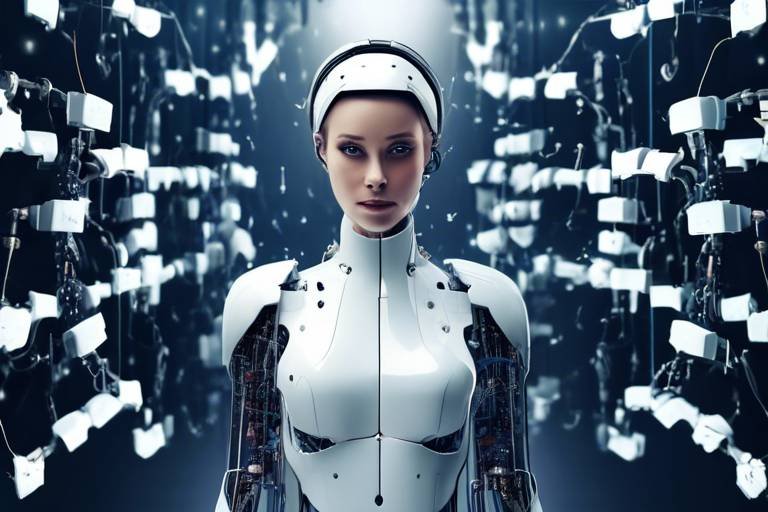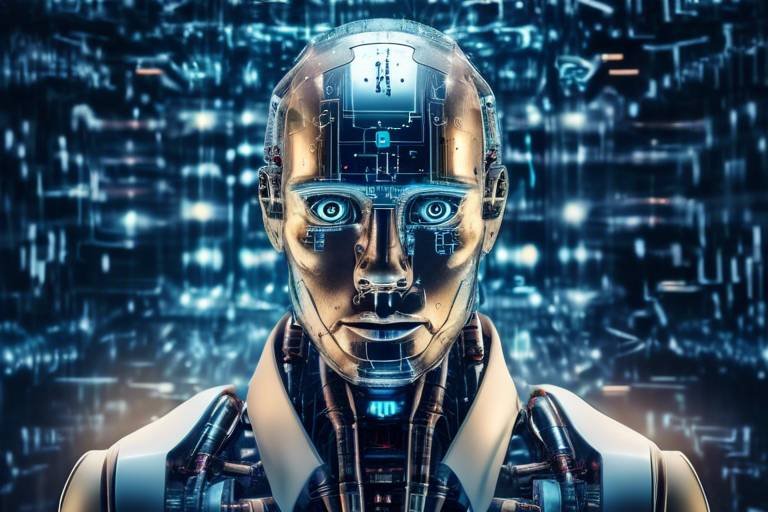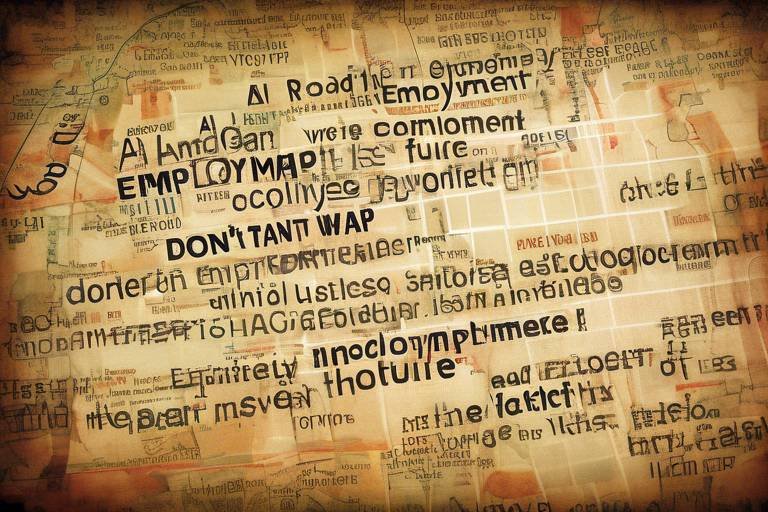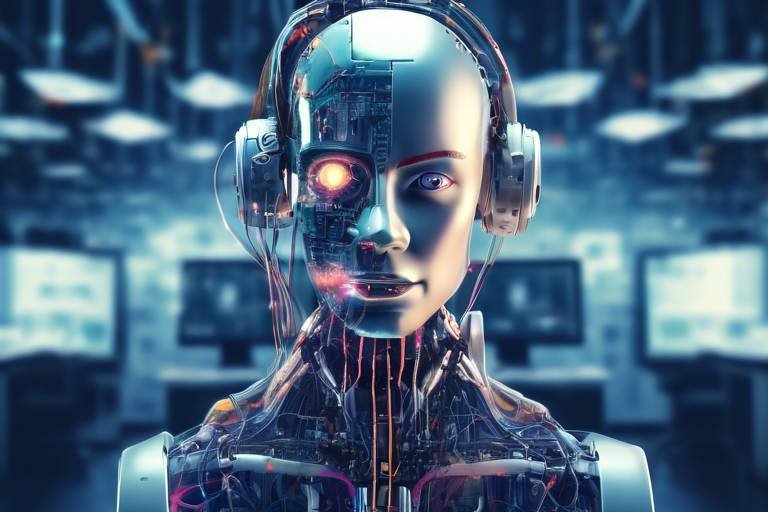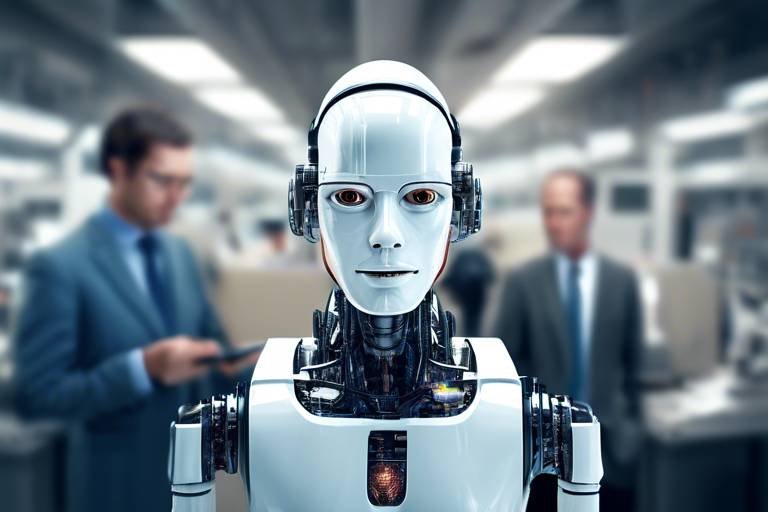Preparing the Next Generation for AI-Driven Future Workplaces
In today's fast-paced world, where technology advances at the speed of light, preparing the next generation for an AI-driven future is not just important; it’s essential. As we stand on the brink of a new era in the workplace, we must equip young professionals with the skills and knowledge needed to thrive in environments increasingly dominated by artificial intelligence. This article explores the essential skills, education, and strategies necessary for success in this evolving landscape.
Artificial Intelligence is revolutionizing the way we work, reshaping job roles, processes, and the overall employment landscape. Imagine a world where mundane tasks are automated, allowing humans to focus on more creative and strategic endeavors. This transformation highlights the need for future generations to adapt to a rapidly changing environment. With AI taking on repetitive tasks, the demand for skilled individuals who can work alongside these intelligent systems is skyrocketing. The question is: Are we ready to embrace this change?
As we look forward, there are several critical skills that young professionals will need to develop. These include problem-solving, creativity, and emotional intelligence, all of which will be vital in navigating AI-driven workplaces. In a world where AI can analyze data faster than any human, the ability to think critically and creatively will set individuals apart. Furthermore, emotional intelligence will play a crucial role in ensuring effective collaboration between humans and machines. After all, while AI can process information, it lacks the human touch that is often essential in teamwork and leadership.
Technical skills, particularly in programming and data analysis, will become increasingly important as the workforce evolves. Understanding how to communicate with AI systems through coding will be a game-changer for many. As we delve deeper into this topic, let's explore the programming languages that will be most relevant for future workers.
Future professionals should focus on learning programming languages that are widely used in AI and technology sectors. Here are a few key languages:
| Programming Language | Application |
|---|---|
| Python | Data analysis, machine learning |
| JavaScript | Web development, AI applications |
| R | Statistical analysis, data visualization |
| Java | Enterprise applications, Android development |
In addition to programming skills, data literacy has become a cornerstone of success in the AI era. Understanding how to interpret AI outputs and make informed decisions based on data is crucial. As businesses increasingly rely on data-driven insights, the ability to analyze and act upon this information will be a significant advantage. Imagine being in a meeting where everyone is discussing data trends, and you can confidently contribute your insights. That’s the power of data literacy!
While technical skills are essential, we must not overlook the importance of soft skills. Skills like communication and teamwork will remain critical as AI takes on more technical tasks. Effective human-AI collaboration will require individuals to articulate their ideas clearly and work well with others. In a world where machines handle the heavy lifting, the human element will shine through in our ability to connect, empathize, and innovate.
To prepare students for this AI-driven future, we need innovative educational models and curricula that focus on AI literacy and interdisciplinary learning. Traditional education systems must evolve to include hands-on experiences that engage students in real-world applications of AI technology.
Incorporating AI concepts into existing educational frameworks is vital for fostering a deeper understanding among students. Schools and universities can introduce courses that explore the ethical implications of AI, its applications in various industries, and the skills required to work alongside these technologies.
Experiential learning opportunities, such as internships and projects, provide students with practical exposure to AI technologies. These experiences not only enhance technical skills but also build confidence and adaptability. Picture a student working on a project that involves developing an AI model; the skills they acquire will be invaluable in their future careers.
Encouraging a growth mindset in students is crucial for adaptability and continuous learning in the face of technological advancements. Emphasizing the idea that abilities can be developed through dedication and hard work will empower students to embrace challenges.
Promoting lifelong learning as a strategy for staying relevant in a rapidly evolving job market influenced by AI is essential. As technology continues to advance, the ability to learn and adapt will be the key to success. Imagine a world where learning never stops; that’s the future we want to create!
Finally, we must equip students with strategies to develop resilience. Facing challenges and uncertainties in their future careers with confidence will be crucial. By fostering a supportive environment that encourages risk-taking and learning from failure, we can help students build the resilience they need to thrive in an unpredictable job market.
- What skills are essential for the future workforce? Critical skills include problem-solving, creativity, emotional intelligence, and technical skills like programming and data analysis.
- How can educational institutions prepare students for AI? By integrating AI concepts into curricula and providing hands-on learning experiences.
- Why is a growth mindset important? It encourages adaptability and continuous learning, which are crucial in a rapidly changing job market.

Understanding AI's Impact on the Workforce
As we stand on the brink of a technological revolution, it's essential to grasp how artificial intelligence (AI) is reshaping the workforce landscape. Imagine walking into an office where machines handle mundane tasks, allowing humans to focus on creative and strategic endeavors. This is not a distant future; it's happening right now! AI technologies are transforming job roles, work processes, and even the very essence of employment itself. From automation of routine tasks to advanced data analysis, AI is not just a tool but a catalyst for change that we must embrace.
The integration of AI into various industries is causing a significant shift in job demands. For instance, the rise of AI-driven customer service bots means that traditional customer service roles are evolving. Employees are now expected to manage more complex interactions that require emotional intelligence and creative problem-solving skills. As a result, the workforce must adapt to these changes, acquiring new skills and mindsets to thrive in an AI-integrated environment.
Moreover, the impact of AI isn't limited to job displacement; it also creates opportunities for new roles that didn't exist before. Consider fields like data science, where professionals analyze vast amounts of data generated by AI systems to derive actionable insights. This shift necessitates a workforce that is not only technically savvy but also adaptable and innovative. As we look to the future, it's crucial to understand that the key to success lies in our ability to adapt and evolve alongside these technological advancements.
To further illustrate the impact of AI on the workforce, let's break down some key areas where AI is making waves:
- Job Creation: New roles in AI management, data analysis, and technology development are emerging.
- Job Transformation: Existing roles are evolving, requiring a blend of technical and soft skills.
- Work Process Changes: AI automates repetitive tasks, allowing employees to focus on strategic initiatives.
- Collaboration with AI: Workers will increasingly collaborate with AI systems, requiring a new set of skills.
In summary, understanding AI's impact on the workforce is not just about recognizing the challenges it presents but also about seizing the opportunities it offers. As we prepare the next generation for this AI-driven future, we must equip them with the skills, knowledge, and mindset needed to navigate this exciting yet complex landscape. The journey ahead may be daunting, but with the right preparation, the future is bright!
Q1: How is AI changing the job market?
A1: AI is transforming the job market by automating routine tasks, creating new job roles, and requiring workers to develop new skills that complement AI technologies.
Q2: What skills will be most important in an AI-driven workplace?
A2: Essential skills include problem-solving, creativity, emotional intelligence, and technical skills like programming and data analysis.
Q3: How can education systems adapt to prepare students for AI integration?
A3: Education systems can integrate AI concepts into curricula, promote hands-on learning experiences, and encourage a growth mindset among students.

Essential Skills for Future Workers
As we navigate through this exciting yet unpredictable era shaped by artificial intelligence, it’s crucial to recognize that the skills needed for success in the workplace are evolving. The future worker must be equipped with a unique blend of abilities that not only complement AI technologies but also leverage human strengths. So, what exactly are these essential skills? Let’s dive in!
First and foremost, problem-solving stands out as a vital skill. In a world where AI can analyze data and provide insights faster than any human, the ability to interpret these insights and apply them to real-world problems becomes critical. Imagine AI as a brilliant chess player; it can predict moves and outcomes, but it’s up to the human player to strategize and make the final call. This is where problem-solving skills come into play—analyzing AI-generated data, understanding its implications, and crafting solutions that drive innovation.
Next, we have creativity. You might wonder, with AI taking over many tasks, how can creativity still hold its ground? Well, think of AI as a powerful tool that can enhance human creativity rather than replace it. While machines can generate ideas based on existing data, they lack the ability to think outside the box and create something entirely new. Future workers will need to harness their creativity to develop unique products, services, and experiences that resonate with people on a personal level. After all, AI can assist in the creative process, but it’s the human touch that adds depth and meaning.
Another indispensable skill is emotional intelligence. As AI takes over more technical tasks, the human element becomes increasingly important. Emotional intelligence encompasses the ability to understand and manage one’s emotions, as well as the emotions of others. In a workplace where collaboration with AI is the norm, workers will need to navigate interpersonal relationships effectively. This means being able to communicate clearly, empathize with colleagues, and foster a positive work environment, ensuring that human connections remain strong despite the technological advancements.
To further illustrate the significance of these skills, let’s take a look at a simple comparison in the table below:
| Skill | Importance | AI's Role |
|---|---|---|
| Problem-Solving | Critical for crafting solutions based on AI insights | Provides data and predictions |
| Creativity | Essential for innovation and unique offerings | Enhances creative processes |
| Emotional Intelligence | Key for effective teamwork and communication | Facilitates understanding of human responses |
Moreover, let’s not forget the importance of technical skills. As we discussed in the previous sections, familiarity with programming languages and data analysis is becoming increasingly necessary. Understanding how to work alongside AI tools will empower workers to harness their full potential. This doesn’t mean everyone needs to become a coding wizard, but having a foundational knowledge of how to interact with technology can set future workers apart in the job market.
Lastly, while we focus on the hard skills, let’s take a moment to appreciate the value of soft skills. Skills like communication, teamwork, and adaptability are paramount in an AI-driven workspace. As machines automate repetitive tasks, the ability to collaborate with others and adapt to changing circumstances will be what differentiates a good employee from a great one. Remember, AI might be able to crunch numbers or follow algorithms, but it can't replicate the warmth of human interaction or the nuances of human thought.
In conclusion, the essential skills for future workers encompass a blend of problem-solving, creativity, emotional intelligence, technical know-how, and soft skills. As we prepare for an AI-integrated workplace, focusing on these skills will not only enhance individual career prospects but also foster a more resilient and innovative workforce.
- What are the most important skills for future workers? The most important skills include problem-solving, creativity, emotional intelligence, technical skills, and soft skills.
- How can I improve my emotional intelligence? You can improve your emotional intelligence by practicing self-awareness, empathy, and effective communication.
- Do I need to learn programming to succeed in an AI-driven workplace? While not everyone needs to be an expert, having a basic understanding of programming and data analysis can be extremely beneficial.

The Role of Technical Skills
In today’s fast-paced world, where technology is evolving at lightning speed, the role of technical skills has never been more critical, especially when it comes to preparing for AI-driven workplaces. Imagine walking into a job where the tools and processes you learned in school are already outdated. Scary, right? That’s why mastering technical skills is like having a golden ticket to the future of work. It’s not just about knowing how to use a computer; it’s about understanding the very technologies that are reshaping our industries.
Technical skills encompass a wide range of competencies, but at their core, they enable individuals to interact effectively with technology. As AI continues to permeate various sectors, being adept at technical skills such as programming, data analysis, and machine learning becomes essential. These skills are not just buzzwords; they are the building blocks of a successful career in an AI-dominated landscape. For instance, programming allows professionals to create and modify algorithms, while data analysis helps in interpreting the vast amounts of information generated by AI systems.
Let’s take a closer look at some of the technical skills that will be vital:
- Programming Languages: Familiarity with languages like Python, Java, and R can open doors to numerous opportunities in tech and data science.
- Data Management: Understanding databases and how to manage data is crucial for making sense of the information AI generates.
- Machine Learning: Knowledge of machine learning concepts can help workers leverage AI tools effectively in their roles.
However, it's not just about acquiring these skills; it’s about applying them. Employers are increasingly looking for candidates who can demonstrate their technical knowledge in real-world scenarios. This means that practical experience, such as internships or project work, is incredibly valuable. In fact, many educational institutions are now emphasizing the importance of hands-on learning experiences that allow students to work directly with AI technologies.
Moreover, the integration of technical skills into various job roles is transforming the employment landscape. For instance, a marketing professional with data analysis skills can optimize campaigns through AI insights, while a healthcare worker with programming knowledge can contribute to developing AI-driven diagnostic tools. This cross-disciplinary approach not only enhances individual career prospects but also drives innovation within organizations.
In summary, as we gear up for a future dominated by AI, the need for robust technical skills cannot be overstated. These skills empower individuals to not only survive but thrive in the evolving job market. So, whether you’re a student mapping out your career path or a professional looking to upskill, investing time in developing your technical abilities is a smart move. After all, in the world of AI, being technically savvy is no longer an option; it’s a necessity.
Q1: What are the most important technical skills to learn for an AI-driven future?
A1: Key technical skills include programming (especially in languages like Python and R), data analysis, and understanding machine learning concepts. These skills help you interact effectively with AI technologies.
Q2: How can I gain practical experience in technical skills?
A2: Look for internships, participate in coding boot camps, or work on personal projects that allow you to apply your skills in real-world situations. Many online platforms also offer hands-on courses.
Q3: Is it too late to learn technical skills if I'm already in my career?
A3: Absolutely not! Lifelong learning is vital in today’s job market. Many professionals successfully transition into tech roles later in their careers by dedicating time to upskill.
Q4: How do soft skills complement technical skills in the workplace?
A4: While technical skills enable you to perform tasks, soft skills like communication and teamwork are essential for collaborating effectively with others and navigating the complexities of a modern workplace.

Programming Languages to Learn
In today's rapidly evolving tech landscape, understanding the right programming languages is crucial for anyone aiming to thrive in an AI-driven workplace. Just as a chef needs to master various cooking techniques to create exquisite dishes, future professionals must become adept in specific programming languages to effectively collaborate with artificial intelligence systems. So, what are the key languages that should be on your radar?
First and foremost, Python stands out as a powerhouse in the realm of AI and machine learning. Its simplicity and readability make it an ideal choice for beginners and experts alike. Python's extensive libraries, such as TensorFlow and PyTorch, allow developers to build complex AI models without getting bogged down in intricate syntax. Imagine Python as the Swiss Army knife of programming—versatile and essential for a variety of tasks.
Next up is JavaScript, a language that has become synonymous with web development. With the increasing integration of AI into web applications, JavaScript is essential for creating interactive and intelligent web experiences. Its frameworks, such as Node.js, enable developers to build server-side applications that can leverage AI capabilities. Think of JavaScript as the glue that holds the digital world together, allowing for seamless interaction between users and AI-driven functionalities.
Another important player is R, particularly for those leaning towards data analysis and statistics. R shines when it comes to data visualization and statistical modeling, making it an invaluable tool for data scientists. In a world where data is king, learning R can empower professionals to extract meaningful insights from vast datasets, much like a detective piecing together clues to solve a mystery.
For those interested in mobile app development, Swift for iOS and Kotlin for Android are essential. Both languages offer modern features and robust performance, making them ideal for creating applications that incorporate AI functionalities. As mobile devices continue to dominate the tech landscape, mastering these languages can open doors to exciting career opportunities.
Lastly, while not as commonly discussed, SQL (Structured Query Language) deserves a mention. As the backbone of database management, SQL allows professionals to interact with and manipulate data stored in relational databases. In an AI context, understanding SQL is critical for accessing and analyzing data, ensuring that the insights generated by AI systems are grounded in solid data foundations.
In summary, the programming languages you choose to learn can significantly impact your career trajectory in an AI-driven world. By focusing on languages like Python, JavaScript, R, Swift, Kotlin, and SQL, you can build a robust skill set that not only enhances your employability but also prepares you to tackle the challenges of tomorrow's workplaces. It's not just about learning to code; it's about equipping yourself with the tools necessary to thrive in a future where AI is an integral part of our professional lives.
- What is the best programming language to start with for AI? Python is widely recommended due to its simplicity and extensive library support.
- Do I need to learn multiple programming languages? While it's beneficial to know several languages, focusing on a few that align with your career goals is more important.
- How long does it take to learn a programming language? The time varies based on the language and your prior experience, but with consistent practice, you can achieve proficiency in a few months.
- Can I learn programming on my own? Absolutely! Many resources, including online courses and tutorials, are available for self-learners.

Data Literacy in the AI Era
In today's fast-paced digital landscape, data literacy has become a cornerstone for success, especially as we navigate the complexities of an AI-driven workplace. But what exactly does it mean to be data literate? At its core, data literacy is the ability to read, understand, create, and communicate data effectively. It's not just about crunching numbers; it's about making sense of the information that surrounds us and using it to inform decisions. As AI continues to permeate various sectors, the demand for individuals who can interpret AI outputs and derive actionable insights is soaring.
Imagine you're a captain of a ship sailing through uncharted waters. Without navigational tools and an understanding of the stars, you'd be lost. Similarly, in the modern workplace, data serves as our navigational chart. It guides us through decision-making processes and strategic planning. To thrive in this environment, future workers must develop a keen sense of data literacy, allowing them to collaborate effectively with AI systems and leverage data to drive innovation.
Moreover, the implications of data literacy extend beyond just individual roles. Organizations that foster a culture of data literacy empower their teams to make informed decisions, leading to enhanced productivity and innovation. When employees can analyze data trends and patterns, they can identify opportunities for improvement and growth. This is where the synergy between AI and human intelligence comes into play. AI can process vast amounts of data at lightning speed, but it's the human touch that interprets those findings within the context of real-world applications.
To illustrate the significance of data literacy, consider the following key components:
- Understanding Data Sources: Knowing where to find reliable data and how to evaluate its credibility is crucial. This includes recognizing biases and limitations in datasets.
- Data Interpretation: The ability to translate raw data into meaningful insights is essential. This involves recognizing patterns, trends, and anomalies that can inform business strategies.
- Data Visualization: Presenting data in a clear and engaging manner allows for better communication of insights. Tools like charts and graphs can make complex information more digestible.
- Ethical Considerations: As data becomes more prevalent, understanding the ethical implications of data use, including privacy concerns and data ownership, is vital.
Incorporating data literacy into educational curricula is imperative for preparing students to meet these challenges head-on. Schools and universities must prioritize teaching students not only how to work with data but also how to think critically about it. This includes fostering skills in statistical analysis, data interpretation, and even basic programming to manipulate data sets effectively.
In conclusion, as we delve deeper into the AI era, the ability to navigate and interpret data will set apart successful professionals from the rest. Data literacy is not merely a skill; it's a vital competency that will empower the next generation to harness the full potential of AI technologies, driving innovation and making informed decisions in their respective fields.
1. What is data literacy?
Data literacy is the ability to read, understand, create, and communicate data effectively. It involves interpreting data to make informed decisions.
2. Why is data literacy important in the AI era?
As AI systems generate vast amounts of data, being data literate allows individuals to interpret these outputs and apply them in real-world scenarios, enhancing decision-making processes.
3. How can I improve my data literacy?
Improving data literacy can be achieved through online courses, workshops, and practical experiences that focus on data analysis, visualization, and interpretation.
4. What role does data literacy play in organizations?
Organizations that promote data literacy empower their employees to make data-driven decisions, leading to improved productivity and innovation.

Soft Skills in an AI World
As we dive deeper into the realm of Artificial Intelligence, it’s easy to get caught up in the shiny, technical aspects of the technology. However, let’s not forget the **human element** that remains crucial in this rapidly evolving landscape. While AI can automate tasks and analyze data, it lacks the **emotional intelligence** and nuanced understanding that only humans can provide. In fact, soft skills like communication, teamwork, and adaptability are becoming more relevant than ever. Think of it this way: if AI is like a powerful engine driving a car, soft skills are the steering wheel that helps navigate through the complexities of human interactions in the workplace.
Communication is one of the most vital soft skills that future workers need to cultivate. In a world where AI can generate reports and insights, the ability to effectively communicate these findings to colleagues and stakeholders becomes essential. It’s not just about presenting data; it’s about telling a story with that data, making it relatable and understandable. Imagine a scenario where an AI system provides a complex analysis of market trends. A skilled communicator can take that information and translate it into actionable strategies that resonate with team members, ensuring everyone is on the same page.
Moreover, teamwork is another area where soft skills shine. As AI takes over more technical tasks, human collaboration will become increasingly important. Teams will need to work together to leverage AI tools effectively, combining their unique strengths to achieve common goals. This is where emotional intelligence comes into play, allowing individuals to navigate interpersonal dynamics, resolve conflicts, and foster a collaborative environment. In essence, the ability to empathize and understand others will be the glue that holds teams together in an AI-driven workplace.
Let’s not overlook the importance of adaptability. The pace of technological change is staggering, and those who can pivot and adjust their skills will thrive. Soft skills empower individuals to embrace change rather than fear it. By cultivating a mindset that welcomes learning and growth, workers can stay relevant in an ever-shifting job market. In fact, studies have shown that companies prioritize candidates with strong soft skills, often placing them ahead of those with only technical prowess. So, while you’re mastering that programming language or diving into data analysis, don’t forget to hone your **soft skills** as well.
In conclusion, as we prepare for an AI-dominated future, let’s remember that technology may enhance our capabilities, but it’s our soft skills that will truly set us apart. The ability to communicate effectively, work collaboratively, and adapt to change will be the bedrock of successful careers in the new workplace. So, invest time in developing these essential skills, and you’ll not only enhance your employability but also contribute positively to the evolving landscape of work.
- What are soft skills? Soft skills are personal attributes that enable someone to interact effectively and harmoniously with other people. They include communication, teamwork, empathy, and adaptability.
- Why are soft skills important in an AI world? As AI takes over more technical tasks, soft skills become crucial for effective collaboration, communication, and navigating interpersonal relationships in the workplace.
- How can I improve my soft skills? You can improve your soft skills through practice and feedback. Engage in team projects, seek opportunities for public speaking, and actively work on your emotional intelligence.
- Are soft skills more important than technical skills? Both soft skills and technical skills are important. However, as automation increases, soft skills may become a key differentiator in the job market.

Educational Approaches for AI Readiness
As we stand on the brink of an AI-driven future, it’s crucial to rethink how we educate the next generation. The traditional methods of teaching are no longer sufficient to prepare students for the complexities of a workplace intertwined with artificial intelligence. Instead, we need to embrace innovative educational models that not only teach technical skills but also foster critical thinking, creativity, and emotional intelligence.
One of the most effective strategies is to integrate AI concepts into existing curricula. This means weaving AI literacy into subjects that students are already familiar with, such as mathematics, science, and even humanities. By doing so, we can create a holistic understanding of how AI operates and its implications on various fields. For instance, students can explore how AI is used in healthcare to analyze patient data or how it influences marketing strategies through consumer behavior analysis.
Moreover, hands-on learning experiences are vital in this educational transformation. Theories are great, but nothing beats real-world application. Schools and universities should prioritize internships, projects, and collaboration with tech companies. These experiences not only provide students with practical exposure to AI technologies but also allow them to work on real-life problems, enhancing their problem-solving skills. Imagine a student working on a project where they develop an AI model to predict climate change impacts—this kind of engagement is invaluable.
In addition to integrating AI into curricula and providing hands-on experiences, fostering a growth mindset is essential. This concept, popularized by psychologist Carol Dweck, emphasizes the importance of viewing challenges as opportunities for growth. Students should be encouraged to embrace failure as a part of the learning process, especially in fields as dynamic as technology and AI. When students develop a growth mindset, they become more adaptable and resilient, traits that are critical in navigating the uncertainties of the future job market.
Ultimately, the goal is to prepare students not just for today’s jobs but for the jobs of tomorrow. This requires a concerted effort from educators, policymakers, and industry leaders to create an ecosystem that supports innovative learning. By focusing on interdisciplinary approaches, practical experiences, and fostering a growth mindset, we can ensure that the next generation is not only ready for the AI-driven future but thrives in it.
- What is AI literacy, and why is it important?
AI literacy refers to understanding how artificial intelligence works and its implications in various fields. It is crucial because it empowers individuals to make informed decisions in an AI-driven world. - How can students gain hands-on experience with AI?
Students can gain hands-on experience through internships, collaborative projects with tech companies, and participating in workshops that focus on AI technologies. - What role do soft skills play in an AI-driven workplace?
Soft skills such as communication, teamwork, and emotional intelligence are essential for effective collaboration with AI systems and for navigating the interpersonal aspects of modern work environments.

Integrating AI into Curricula
As we stand on the brink of an AI revolution, the need to integrate AI into educational curricula has never been more pressing. Schools and universities must adapt their teaching methods to prepare students for a future where artificial intelligence is not just a tool but a collaborator in the workplace. This integration is not merely about teaching students how to use AI; it's about fostering a deep understanding of its implications, applications, and ethical considerations. Imagine a classroom where students don’t just learn about AI but actively engage with it, developing projects that utilize machine learning algorithms or exploring the ethical dilemmas posed by autonomous systems.
One effective approach to integrating AI into curricula is through interdisciplinary learning. By combining subjects like computer science, ethics, and social studies, educators can provide a holistic view of AI's role in society. For instance, a project could involve students analyzing how AI impacts job markets while also learning to code a simple AI application. This not only enhances their technical skills but also encourages critical thinking and ethical reasoning. Furthermore, schools can introduce AI-themed competitions, workshops, and hackathons that ignite students' passion for technology and innovation.
Moreover, hands-on experiences are essential to this integration. Students should have opportunities to work on real-world problems using AI technologies. This could be achieved through partnerships with tech companies or local organizations that allow students to apply their knowledge in practical settings. For example, students could collaborate with a local business to analyze customer data using AI tools, gaining invaluable experience while contributing to their community. Such collaborations not only enrich students’ learning experiences but also help bridge the gap between theory and practice.
To further enhance AI literacy, educators should consider the following strategies:
- Curriculum Development: Revamping existing curricula to include AI concepts across various subjects.
- Teacher Training: Providing professional development for teachers so they feel confident in teaching AI-related content.
- Resource Allocation: Investing in AI tools and resources that facilitate hands-on learning.
Ultimately, integrating AI into curricula is about preparing students for a future where they can thrive alongside advanced technologies. It’s about equipping them with not just the technical skills, but also the critical thinking and ethical judgment necessary to navigate an AI-driven world. By fostering an environment that encourages exploration and innovation, we can ensure that the next generation is not only ready for the future but is also capable of shaping it.
Q1: Why is it important to integrate AI into school curricula?
A1: Integrating AI into curricula prepares students for future job markets, enhances their problem-solving skills, and fosters critical thinking about technology's impact on society.
Q2: How can schools effectively teach AI concepts?
A2: Schools can teach AI concepts through interdisciplinary projects, hands-on experiences, and partnerships with tech companies to provide real-world applications.
Q3: What role do teachers play in this integration?
A3: Teachers are crucial in facilitating AI education by developing their own skills, creating engaging lessons, and mentoring students through projects that involve AI technologies.
Q4: Are there any resources available for educators?
A4: Yes, there are numerous online platforms, courses, and workshops dedicated to AI education that can help teachers develop their curricula and improve their knowledge.

Hands-On Learning Experiences
In today’s fast-paced world, where the winds of change blow fiercely thanks to technological advancements, are becoming more crucial than ever. Imagine trying to learn how to ride a bike by just reading about it—sure, you might understand the theory, but it’s the actual practice that builds your confidence and skills. Similarly, when it comes to preparing for an AI-driven workplace, students need to engage in practical, real-world experiences that bridge the gap between theory and application.
One of the most effective ways to achieve this is through internships. These opportunities allow students to step into the shoes of professionals and experience the dynamics of an AI-integrated work environment firsthand. Internships not only provide a platform to apply theoretical knowledge but also help students to build a network of industry contacts, which can be invaluable in their future careers. Moreover, they offer a glimpse into the daily challenges and exciting projects that drive innovation in the field.
Another vital component is project-based learning. Schools and universities can foster environments where students collaborate on real projects, perhaps even partnering with local businesses or tech companies. This collaboration can take various forms, such as:
- Hackathons: These intensive events challenge students to create solutions to real-world problems using AI technologies within a limited time frame.
- Capstone Projects: These projects typically occur at the end of a degree program, allowing students to tackle a significant challenge that showcases their learning and creativity.
- Research Initiatives: Engaging in research can provide students with insights into cutting-edge technologies and methodologies.
Moreover, incorporating simulations into the curriculum can be a game-changer. Simulations allow students to experiment with AI tools in a controlled environment, enabling them to make mistakes, learn from them, and refine their skills without the pressure of real-world consequences. This hands-on approach not only enhances understanding but also builds confidence as students see their ideas come to life.
Furthermore, educational institutions can leverage online platforms that offer interactive learning experiences. These platforms often provide access to AI tools and resources, enabling students to experiment with coding, data analysis, and AI model development from the comfort of their homes. This flexibility is particularly important for students who may not have access to advanced technology in their local environments.
In summary, hands-on learning experiences are not just beneficial; they are essential for preparing students for the future workforce. By engaging in internships, project-based learning, simulations, and online platforms, students can gain the skills and confidence needed to thrive in an AI-driven workplace. The key lies in striking a balance between theoretical knowledge and practical application, ensuring that the next generation is not just ready for the future but is also eager to embrace it.
1. Why are hands-on learning experiences important for students?
Hands-on learning experiences allow students to apply theoretical knowledge in real-world situations, enhancing their understanding and skills while building confidence in their abilities.
2. What types of hands-on experiences should students seek?
Students should look for internships, project-based learning opportunities, and simulations that provide practical exposure to AI technologies and workplace dynamics.
3. How can schools incorporate hands-on learning into their curricula?
Schools can partner with local businesses for internships, implement project-based learning frameworks, and utilize online platforms that offer interactive experiences in AI and technology.
4. What role do simulations play in hands-on learning?
Simulations provide a safe environment for students to experiment with AI tools, allowing them to learn from mistakes and refine their skills without real-world consequences.

Fostering a Growth Mindset
In today's fast-paced world, where technological advancements are a daily occurrence, fostering a growth mindset is more important than ever. But what exactly does it mean to have a growth mindset? Essentially, it's the belief that abilities and intelligence can be developed through dedication and hard work. This perspective creates a love for learning and resilience, which are essential qualities for navigating the uncertainties of an AI-driven workplace. Instead of viewing challenges as insurmountable obstacles, individuals with a growth mindset see them as opportunities for growth and improvement.
Encouraging students to adopt this mindset can significantly impact their future careers. It helps them embrace challenges, persist in the face of setbacks, and learn from criticism. Imagine a young professional who encounters a complex AI tool for the first time. With a growth mindset, they won't shy away from it; instead, they will dive in, experiment, and learn from any mistakes they make along the way. This proactive approach not only enhances their skills but also builds their confidence, making them more adaptable in a rapidly changing work environment.
To cultivate a growth mindset, educators and parents alike can implement several strategies. One effective method is to promote lifelong learning. This means encouraging students to seek knowledge and skills beyond their formal education. For example, they can engage in online courses, attend workshops, or participate in community projects. By viewing learning as a continuous journey rather than a destination, students will be better prepared to adapt to new technologies and workplace demands.
Another key strategy is to help students build resilience. Resilience is the ability to bounce back from failures and setbacks, and it is crucial in a world where AI and technology are constantly evolving. Educators can foster resilience by creating a safe environment where students feel comfortable taking risks and making mistakes. For instance, in a classroom setting, teachers can encourage group discussions where students share their challenges and how they overcame them. This not only normalizes failure but also builds a supportive community that promotes growth.
Moreover, incorporating feedback into the learning process is vital. Constructive feedback helps students understand their strengths and areas for improvement. When feedback is framed positively, it encourages students to view it as a tool for development rather than criticism. For example, instead of saying, "You did this wrong," a teacher might say, "This is a great start! Here’s how you can enhance your work." This approach nurtures a growth mindset by emphasizing the potential for improvement and learning.
In conclusion, fostering a growth mindset is not just about encouraging students to work hard; it's about instilling a belief in their ability to grow, adapt, and thrive in an AI-driven world. By promoting lifelong learning, resilience, and constructive feedback, we can prepare the next generation to face the challenges of the future with confidence and creativity. The journey toward success is not a straight path, but with a growth mindset, every twist and turn becomes an opportunity for exploration and development.
- What is a growth mindset?
A growth mindset is the belief that abilities and intelligence can be developed through dedication and hard work. - How can I foster a growth mindset in students?
Encourage lifelong learning, promote resilience, and provide constructive feedback. - Why is resilience important in an AI-driven workplace?
Resilience helps individuals bounce back from failures and adapt to new challenges, which is crucial in a rapidly evolving job market.

Encouraging Lifelong Learning
In today's fast-paced world, the concept of lifelong learning has become more than just a buzzword; it is a vital strategy for success, especially in an AI-driven workplace. As technology continues to evolve at breakneck speed, the ability to adapt and learn continuously is essential for anyone looking to stay relevant in their career. Think of it as a never-ending journey, where each new skill acquired is like a stepping stone leading you to greater opportunities and success.
So, how can we encourage this mindset in students? First, we need to foster an environment where curiosity is celebrated. When students are encouraged to ask questions and explore topics that interest them, they naturally develop a love for learning. This is especially important in fields related to AI, where the landscape is constantly changing. By embracing a culture of inquiry, students can learn to seek out knowledge beyond the classroom, whether through online courses, workshops, or self-directed projects.
Moreover, we should emphasize the importance of setting personal learning goals. Just like a fitness journey, where you track your progress and celebrate small victories, lifelong learning can be approached in a similar manner. Encourage students to identify skills they want to acquire or subjects they wish to explore. This could be anything from mastering a new programming language to understanding the ethical implications of AI. By setting clear, achievable goals, students can maintain motivation and see their growth over time.
Another effective strategy is to integrate technology into the learning process. With the rise of online platforms offering courses on a myriad of topics, students have unprecedented access to resources. For instance, platforms like Coursera, edX, and Udacity provide courses that can be tailored to individual interests and career aspirations. By guiding students to utilize these resources, we can help them take charge of their learning journey. Additionally, using collaborative tools like Slack or Trello can foster teamwork and project management skills, which are invaluable in any career.
To further instill a sense of lifelong learning, we should also highlight the importance of networking and mentorship. Engaging with professionals in their desired fields can provide students with insights and guidance that are crucial for their development. Whether through formal mentorship programs or casual networking events, these interactions can inspire students to pursue new learning opportunities and stay updated on industry trends.
In conclusion, encouraging lifelong learning is about creating a mindset that values curiosity, goal-setting, and adaptability. As we prepare students for the future, we must equip them with the tools and resources they need to embrace continuous learning. After all, in a world increasingly shaped by AI, those who are willing to learn and grow will undoubtedly thrive.
- What is lifelong learning? Lifelong learning is the ongoing, voluntary, and self-motivated pursuit of knowledge for personal or professional development.
- Why is lifelong learning important in the AI era? As technology evolves, new skills are constantly required. Lifelong learning helps individuals stay relevant and competitive in the job market.
- How can I promote lifelong learning in my career? Set personal learning goals, utilize online resources, engage with mentors, and stay curious about new developments in your field.

Building Resilience in Students
In today's fast-paced world, building resilience in students is more crucial than ever. As they prepare to enter an AI-driven workforce, they will inevitably face challenges and uncertainties that require a strong mental and emotional foundation. But what exactly does it mean to be resilient? Resilience is the ability to bounce back from setbacks, adapt to change, and keep moving forward despite obstacles. It's like being a rubber band; the more you stretch, the stronger you become. So, how can educators and parents help cultivate this invaluable trait in young minds?
One effective approach is to create an environment that promotes positive risk-taking. This means encouraging students to step out of their comfort zones and try new things, whether it's tackling a challenging project or participating in a debate. When they face difficulties, it's essential to help them view these as opportunities for growth rather than failures. For instance, when a student struggles with a coding assignment, instead of simply telling them the solution, a mentor can guide them to analyze their mistakes and learn from them. This not only builds resilience but also reinforces problem-solving skills, which are vital in an AI-integrated workplace.
Additionally, fostering a supportive community is key. When students feel connected to their peers and teachers, they are more likely to seek help when needed. This can be achieved through group projects, team-building activities, and open communication channels. For example, establishing peer mentorship programs can allow students to share experiences and strategies for overcoming challenges, creating a sense of belonging and mutual support.
Moreover, teaching students about mindfulness and stress management techniques can significantly enhance their resilience. Techniques like meditation, deep breathing exercises, and time management skills can empower students to handle stress more effectively. By incorporating these practices into the school routine, educators can help students build a toolkit for managing anxiety, which is particularly important as they navigate the pressures of future careers.
Lastly, it's crucial to instill a growth mindset in students. This concept, popularized by psychologist Carol Dweck, emphasizes the belief that abilities and intelligence can be developed through dedication and hard work. By encouraging students to embrace challenges, persist in the face of setbacks, and learn from criticism, we prepare them to thrive in an ever-evolving job market. Schools can promote this mindset by celebrating effort over outcome, thereby reinforcing the idea that resilience is built through perseverance.
In summary, building resilience in students is a multifaceted endeavor that requires a supportive environment, encouragement of positive risk-taking, mindfulness practices, and the promotion of a growth mindset. By equipping students with these tools, we not only prepare them for the challenges of an AI-driven future but also empower them to face life's uncertainties with confidence and strength.
- What is resilience, and why is it important for students?
Resilience is the ability to recover from setbacks and adapt to change. It's essential for students as it helps them navigate challenges in their academic and future professional lives. - How can teachers promote resilience in the classroom?
Teachers can promote resilience by creating a supportive environment, encouraging risk-taking, and teaching stress management techniques. - What role do parents play in building resilience?
Parents can support resilience by fostering open communication, encouraging perseverance, and modeling resilience in their own lives.
Frequently Asked Questions
-
What skills should I focus on to thrive in an AI-driven workplace?
To thrive in an AI-driven workplace, you should focus on developing both technical and soft skills. Technical skills like programming, data analysis, and understanding AI tools are crucial. Additionally, soft skills such as creativity, problem-solving, and emotional intelligence will help you navigate the complexities of human-AI collaboration.
-
How is AI changing the job market?
AI is reshaping the job market by automating routine tasks and creating new roles that require advanced technical skills and a deeper understanding of AI technologies. This shift emphasizes the need for workers to adapt by acquiring new skills and being open to continuous learning.
-
What programming languages are most relevant for future workers?
Some of the most relevant programming languages for future workers include Python, R, and Java. Python, in particular, is widely used in AI and machine learning due to its simplicity and versatility. Learning these languages can enhance your ability to work with AI systems and contribute to innovative projects.
-
Why is data literacy important in the AI era?
Data literacy is essential in the AI era because it enables individuals to understand, interpret, and make informed decisions based on data. As workplaces become increasingly data-driven, being able to analyze and draw insights from data will be a key skill that enhances your employability and effectiveness in any role.
-
How can educational institutions prepare students for AI-related careers?
Educational institutions can prepare students for AI-related careers by integrating AI concepts into their curricula, promoting hands-on learning experiences, and encouraging interdisciplinary studies. This approach helps students gain a comprehensive understanding of AI and its applications, making them more competitive in the job market.
-
What is a growth mindset, and why is it important?
A growth mindset is the belief that abilities and intelligence can be developed through dedication and hard work. This mindset is crucial in today's rapidly changing job landscape, as it encourages adaptability, resilience, and a commitment to lifelong learning, which are essential for success in an AI-driven world.
-
How can I build resilience to face future career challenges?
Building resilience involves developing coping strategies, maintaining a positive attitude, and learning from failures. Engaging in challenges, seeking feedback, and continuously improving your skills will help you become more adaptable and better equipped to handle uncertainties in your future career.



